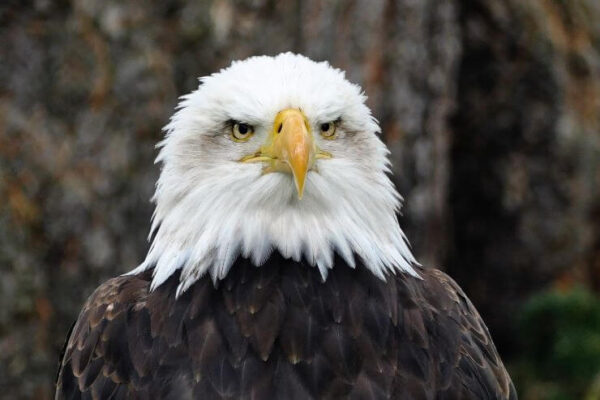Both ornithologists and birdwatchers have long been captivated by the eyes of birds. But as the light sets, are our feathery pals really blind? For those with limited time, the following is a brief response to your inquiry: Though certain bird species have evolved to see well in low light, most birds have poor night vision.
We’ll shed light on birds’ nighttime vision skills in this extensive tutorial. We’ll examine how human vision differs from that of birds, examine how the architecture of the eyes contributes to or hinders night vision, examine species variations, and discuss how light pollution affects nocturnal birds.
Comparing Human Vision with Bird Vision:
Photoreceptors and Color Detection
Birds are far more visually superior than humans. Birds have four kinds of photoreceptor cells in their eyes, compared to three in human eyes. The ultraviolet photoreceptor is an additional photoreceptor that birds have that enables them to perceive ultraviolet light, which is undetectable to human vision.
For birds, this capacity is especially helpful in locating food, seeing possible partners, and navigating their surroundings.
In addition, compared to humans, birds’ color vision is more varied. Birds sense a wider range of hues, including ultraviolet and infrared, than humans can. Humans can see colors ranging from red to violet.
Birds benefit from this enhanced color vision in a number of ways, including recognizing ripe food and hiding from predators.
Seeing Sharply
Once again, birds are more acute than humans in this regard. Birds can see more clearly and precisely because their retinas have a larger concentration of photoreceptor cells. Birds can more easily travel across complicated habitats and detect tiny prey from a distance because of their improved visual acuity.
The typical visual acuity of humans is 20/20, although many bird species have been proven to have significantly sharper eyesight. For instance, it has been said that the peregrine falcon, renowned for its extraordinary hunting prowess, has around 20/2 visual acuity.
In other words, a person with perfect eyesight would need to be at a distance of two feet in order to see an item well, but a peregrine falcon can see it from twenty feet.
Motion Recognition
Birds are very skilled at identifying possible dangers or prey because of their extraordinary ability to perceive motion. Because of the training their eyes have received to recognize even the smallest movement, they are able to respond to their surroundings swiftly and effectively.
In contrast, the human sense of motion perception is more restricted. Birds are able to notice even the slightest motions, such the slight swaying of tree branches or the twitch of a tiny bug, but humans are only able to discern greater movements.
Birds have a major edge in their everyday operations as a result of their enhanced motion sensing.
Specialized Low-Light Vision Adaptations
Ever wonder how birds manage to locate food and navigate in the dark? Well, they’ve evolved some amazing adaptations that let them see in dim light. Let’s examine a few of their unique low-light vision adaptations.
A rise in rod cells
Birds have more rod cells in their eyes than humans do, which is one of the key reasons they see better at night. Light is detected by rod cells, which are especially sensitive to low light levels.
Birds can see more clearly in low light thanks to the quantity of rod cells in their eyes, which facilitates their ability to see in the dark.
Lucidum Tapetum
A unique layer of cells known as the tapetum lucidum is another adaption that provides birds with an advantage in low light. In order to increase the quantity of light accessible for vision, this reflective layer, which is situated beneath the retina, functions like a mirror by reflecting light back through the retina.
As light is reflected from their eyes, this helps birds see better in the dark and gives their eyes a distinctive sparkling look.
Student Form
A bird’s ability to see in low light also depends on the form of its pupil. Many birds have vertically elongated pupils, while humans have spherical pupils. More light can reach the eye because of its extended form, particularly in dimly lit areas.
In addition to helping birds adapt to changing light levels, the capacity to rapidly dilate and constrict their pupils also enables them to see well under a variety of lighting circumstances.
Favorite Position
Birds’ ability to see in the dark is also influenced by the location of the fovea, a tiny region of the retina that is responsible for detailed vision. The fovea is positioned off-central in birds’ retinas as opposed to the center in humans’ retinas.
Birds can concentrate on items without directly staring at them because of this off-center positioning, which also broadens their range of vision and enhances their peripheral vision. This is especially helpful for hunting and low-light navigation.
Differences Amongst Bird Species
There are interesting differences in the night vision abilities of several bird species. Their behavior, physical traits, and adaptations all exhibit these variances. Let’s examine some of the most intriguing variations between bird species in more detail.
Owls and Other Birds of the Night
Owls are known for having very good night vision. These birds have evolved to be excellent in low light thanks to their big eyes and high rod cell concentration in their retinas. Their capacity to detect even the smallest movement in the dark is enhanced by the “tapetum lucidum,” a specialized tissue that lines the inside of their retinas and reflects light back through it.
They have a clear edge while hunting at night because of this.
Nightjars and nighthawks are two more nocturnal birds with modifications that improve their night vision. Compared to their diurnal counterparts, these birds’ pupils are bigger, letting in more light.
They also have more rod cells in their retinas, which makes them more sensitive to low light levels.
The Distinctions Between Predators and Prey
Not only do different bird species have different night vision, but predator and prey birds also have different night vision. To evade nighttime predators, tiny birds that feed on mice or insects, for instance, have evolved outstanding night vision.
Because their retinas include more rod cells than other types, they are able to distinguish minute movements and possible dangers in the dark.
In contrast, predatory birds have evolved to be better at seeing their prey. For example, the retinas of some raptors, such as eagles and hawks, include a higher density of cone cells, which are in charge of color vision and visual acuity.
During the day, when they are most active, this adaptation aids in their ability to see their prey.
Navigating Migration at Night
Numerous bird species migrate over great distances—thousands of kilometers, at times. A number of different navigational signals are used by birds to direct them during nighttime migrations.
Researchers think that birds utilize a mix of astronomical signals, such as the stars and moon, as well as magnetic fields to orient themselves, but the precise processes are still unclear.
According to studies, birds that migrate at night, such as warblers and thrushes, can sense and understand magnetic fields, which aids in their navigation. They can travel with amazing accuracy and precision thanks to this amazing skill, and they can arrive at their locations without getting lost.
Gaining knowledge about how different bird species see the dark might help us better understand their behavior and means of survival. Birds never cease to astound us with their extraordinary talents, whether it’s the owl’s outstanding night vision, the specific adaptations of predatory and prey birds, or the migratory species’ exceptional navigational capabilities.
Dangers to Night Vision in Birds: Light Pollution
Light pollution is a severe danger to birds’ ability to see at night. Artificial nighttime light has expanded along with the growth of cities and metropolitan regions. The overabundance of artificial light may make it difficult for birds to locate food and navigate at night.
Bright city lights may interfere with the natural light signals that birds depend on from the moon and stars to navigate them, confusing their internal navigation systems. This may cause confusion and make you more vulnerable to predators.
The National Audubon Society claims that light pollution has an annual impact on millions of birds. Birds may get confused by bright lights and crash into other buildings or structures. Additionally, they could start to feel drawn to lit windows because they mistake them for open areas.
It is crucial that towns and people adopt appropriate lighting practices, such as using shielded lights and cutting out superfluous outdoor lighting, to lessen this hazard.
Check out the website of the Audubon Society for further details about light pollution and its effects on birds.
Loss of Habitat
The lack of habitat is another danger to birds’ ability to see at night. The loss of natural, gloomy habitats is a consequence of human activity, depriving birds of their primary means of nighttime rest and feeding.
Their natural activities may be disturbed by this habitat loss, which may also make it more challenging for them to see and move about in the dark.
Research that was published in the journal Nature claims that the loss of habitat has caused several bird species’ numbers to drop globally. Their capacity to live and flourish may be significantly impacted by the loss of dark, undisturbed environments.
The preservation of birds’ night vision and general health depends on the protection and restoration of their natural habitats.
Collisions with windows
Another risk to a bird’s night vision is window impacts. Glass windows may go unnoticed by birds, who may fly into them and suffer injuries or even die. This is particularly frequent at night, when bright lights may lure birds, causing them to inadvertently fly in their direction.
The American Bird Conservancy estimates that window crashes kill up to a billion birds annually in the United States alone. There are a number of things that may be done to avoid these accidents, such as putting feeders and plants away from windows, keeping blinds or curtains drawn at night, and applying window decals or films that increase the visibility of glass to birds.
Visit the American Bird Conservancy’s website for further information on reducing window crashes and safeguarding wildlife.
Final Thoughts
Many birds lack good night vision, but certain species have developed exceptional night vision. Appreciating the variety of avian lives is strengthened by knowing how birds utilize their unique sight.
But as light pollution increases, the night sky is becoming brighter, endangering the normal cycles of birds.



![Sparrow Symbolism [Everything You Need to Know]](https://birdsology.com/wp-content/uploads/2023/08/27424329288_186b0579ce_b-600x400.jpg)
![Does The Angry Birds Movie Promote Anti-Immigration Sentiments? [Explained]](https://birdsology.com/wp-content/uploads/2024/01/14609.webp-600x400.webp)

2 thoughts on “Can Birds See In The Dark?”